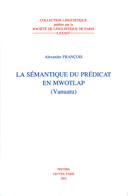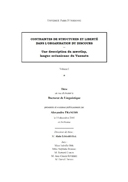Academic publications (original) (raw)
A Mwotlap – French – English cultural dictionary. Electronic file. Paris: CNRS.
→
Online version () : interactive edition, regularly updated, with search engine
→
Printable version (2023): citable, reference edition
 The Pdf file is the 2023 version of my Mwotlap–French–English cultural dictionary. Started in 1998, this dictionary (in progress) now has 2570 entries. More words, senses and examples will be added over future years; but this 2023 edition of my dictionary already provides the essential vocabulary on the Mwotlap language, with insights into the culture and society of northern Vanuatu.
The Pdf file is the 2023 version of my Mwotlap–French–English cultural dictionary. Started in 1998, this dictionary (in progress) now has 2570 entries. More words, senses and examples will be added over future years; but this 2023 edition of my dictionary already provides the essential vocabulary on the Mwotlap language, with insights into the culture and society of northern Vanuatu.
2021
2019
Siva Kalyan, Alexandre François & Harald Hammarström (eds), Understanding language genealogy: Alternatives to the tree model. Special issue of Journal of Historical Linguistics 9/1.
 There are important reasons to be sceptical of the accuracy and usefulness of the family-tree model in historical linguistics. That model assumes that every linguistic innovation applies to a language considered as an undifferentiated whole, a point with no “width”. But this assumption makes it impossible to use a tree to model the partial diffusion of an innovation within a language community (“internal diffusion”), or the diffusion of an innovation across language communities (“external diffusion”). These limitations have long been noticed by historical linguists (Schmidt 1872, Schuchardt 1900); but they become glaringly obvious in the cases discussed by Ross (1988) and François (2014) under the heading of “linkages” – i.e., language families that arise through the diversification, in situ, of a dialect network. The articles in this special issue all contribute towards addressing this problem, from a range of perspectives.
There are important reasons to be sceptical of the accuracy and usefulness of the family-tree model in historical linguistics. That model assumes that every linguistic innovation applies to a language considered as an undifferentiated whole, a point with no “width”. But this assumption makes it impossible to use a tree to model the partial diffusion of an innovation within a language community (“internal diffusion”), or the diffusion of an innovation across language communities (“external diffusion”). These limitations have long been noticed by historical linguists (Schmidt 1872, Schuchardt 1900); but they become glaringly obvious in the cases discussed by Ross (1988) and François (2014) under the heading of “linkages” – i.e., language families that arise through the diversification, in situ, of a dialect network. The articles in this special issue all contribute towards addressing this problem, from a range of perspectives.
2015
(A. François, S. Lacrampe, M. Franjieh & S. Schnell, eds) The Languages of Vanuatu: Unity and Diversity. Studies in the Languages of Island Melanesia, 5. Canberra: Asia–Pacific Linguistics Open Access. 271 pp. (ISBN: 978-1922185235).
→ Reference page for this volume, including download links
→Download the entire book in open access [4.5 Mb]
 With an estimated 138 different indigenous languages, Vanuatu is the country with the highest linguistic density in the world. While they all belong to the Oceanic family, these languages have evolved in three millennia, from what was once a unified dialect network, to the mosaic of different languages that we know today. In this respect, Vanuatu constitutes a valuable laboratory for exploring the ways in which linguistic diversity can emerge out of former unity. This volume represents the first collective book dedicated solely to the languages of this archipelago, and to the various forms taken by their diversity. Its ten chapters cover a wide range of topics, including verbal aspect, valency, possessive structures, numerals, space systems, oral history and narratives. The languages of Vanuatu: Unity and Diversity provides new insights onto the many facets of Vanuatu's rich linguistic landscape.
With an estimated 138 different indigenous languages, Vanuatu is the country with the highest linguistic density in the world. While they all belong to the Oceanic family, these languages have evolved in three millennia, from what was once a unified dialect network, to the mosaic of different languages that we know today. In this respect, Vanuatu constitutes a valuable laboratory for exploring the ways in which linguistic diversity can emerge out of former unity. This volume represents the first collective book dedicated solely to the languages of this archipelago, and to the various forms taken by their diversity. Its ten chapters cover a wide range of topics, including verbal aspect, valency, possessive structures, numerals, space systems, oral history and narratives. The languages of Vanuatu: Unity and Diversity provides new insights onto the many facets of Vanuatu's rich linguistic landscape.
2015
(with Jean-Michel Charpentier) Atlas Linguistique de la Polynésie Française – Linguistic Atlas of French Polynesia. Berlin & Papeete: Mouton de Gruyter & Université de la Polynésie Française. 2562 pp. (ISBN: 978-3-11-026035-9).
→ Reference page for this volume, including download links
[doi:10.1515/9783110260359]
 The vast territory of French Polynesia is home to seven distinct languages – Tahitian, Austral, Ra’'ivavae, Rapa, Mangarevan, Pa'umotu and Marquesan – which in turn show internal variation. The fruit of ten years of joint work by two linguists of French CNRS, Jean-Michel Charpentier and Alexandre François, the Linguistic Atlas of French Polynesia pays tribute to the rich linguistic landscape of the country by documenting thoroughly twenty different communalects, in the form of 2250 maps. Organised by topics (body, life, individual and society, culture and technology, flora and fauna), these lexical maps are supplemented by explanatory notes and indexes in French, English, Tahitian. Text chapters in French and English present the social profile and the historical dynamics of the territory's languages, which are all endangered to various extents. Published in open access, this multilingual and comparative atlas provides an essential reference to scholars and teachers alike, as well as to a broader audience keen to explore and preserve the linguistic heritage of the Pacific region.
The vast territory of French Polynesia is home to seven distinct languages – Tahitian, Austral, Ra’'ivavae, Rapa, Mangarevan, Pa'umotu and Marquesan – which in turn show internal variation. The fruit of ten years of joint work by two linguists of French CNRS, Jean-Michel Charpentier and Alexandre François, the Linguistic Atlas of French Polynesia pays tribute to the rich linguistic landscape of the country by documenting thoroughly twenty different communalects, in the form of 2250 maps. Organised by topics (body, life, individual and society, culture and technology, flora and fauna), these lexical maps are supplemented by explanatory notes and indexes in French, English, Tahitian. Text chapters in French and English present the social profile and the historical dynamics of the territory's languages, which are all endangered to various extents. Published in open access, this multilingual and comparative atlas provides an essential reference to scholars and teachers alike, as well as to a broader audience keen to explore and preserve the linguistic heritage of the Pacific region.
2014
François, Alexandre. Structures et dynamiques des systèmes linguistiques: Documentation, description, comparaison des langues océaniennes. Dissertation for Habilitation à Diriger des recherches. Paris: Institut National des Langues et Civilisations Orientales.
 This dissertation forms part of the set of files I had to produce for my "Habilitation à Diriger des Recherches" degree in June 2014. Habilitation is required in French academia, for one to be entitled to supervise students. This 150-page document answers the requirement, within the Habilitation, to write (in French) a synthesis of my work and publications since I began my career as a linguist (1997-2014).
This dissertation forms part of the set of files I had to produce for my "Habilitation à Diriger des Recherches" degree in June 2014. Habilitation is required in French academia, for one to be entitled to supervise students. This 150-page document answers the requirement, within the Habilitation, to write (in French) a synthesis of my work and publications since I began my career as a linguist (1997-2014).
2013
François, Alexandre & Monika Stern. Music of Vanuatu: Celebrations and Mysteries. Ebook accompanying the CD album Musiques du Vanuatu: Fêtes et Mystères – Music of Vanuatu: Celebrations and Mysteries. Inédit, W 260147. Paris: Maison des Cultures du Monde.
→ Online presentation
→ The complete booklet (bilingual) in Open Access
→ English version, printer-friendly
→ Publisher’s page
 The musical arts of Vanuatu remain largely undocumented - whether in the detail of their instruments, melodies and rhythms, or the poetic forms and styles used in the songs themselves. And yet, these artistic practices include treasures worthy of being brought to light. This album aims to recreate the various musical atmospheres experienced by Vanuatu people in their lives. After listening to nature and the music it inspires, this musical journey meets daily life at the village with wedding and end-of-mourning ceremonies with dances, singing and drumming. The secular world of the village contrasts with the closed circles of important chiefs and Big Men, whose solemn grade-taking ceremonies are marked by the large slit gongs. Finally, comes the time of mystery. Initiates revive the dead and the ancestors with their song language and supernatural powers. Announced by the bullroarer, their steps dance to the sound of groaning voices and strange cries, punctuated by their drums and rattles. These field recordings were collected between 1997 and 2010 in Torres, Banks, Pentecost, Ambae and Maewo Islands.
The musical arts of Vanuatu remain largely undocumented - whether in the detail of their instruments, melodies and rhythms, or the poetic forms and styles used in the songs themselves. And yet, these artistic practices include treasures worthy of being brought to light. This album aims to recreate the various musical atmospheres experienced by Vanuatu people in their lives. After listening to nature and the music it inspires, this musical journey meets daily life at the village with wedding and end-of-mourning ceremonies with dances, singing and drumming. The secular world of the village contrasts with the closed circles of important chiefs and Big Men, whose solemn grade-taking ceremonies are marked by the large slit gongs. Finally, comes the time of mystery. Initiates revive the dead and the ancestors with their song language and supernatural powers. Announced by the bullroarer, their steps dance to the sound of groaning voices and strange cries, punctuated by their drums and rattles. These field recordings were collected between 1997 and 2010 in Torres, Banks, Pentecost, Ambae and Maewo Islands.
(2011)
2003
La Sémantique du Prédicat en Mwotlap (Vanuatu). Collection Linguistique de la Société de Linguistique de Paris. Leuven-Paris: Peeters. 408 pp. (ISBN: 9789042912717).
→ Presentation
→ Flick and search through this book (with Google Book Search)
→Download the entire book in open access [2.3 Mb]
 Mwotlap is an unwritten language spoken by about 1800 people in the Banks Is., Vanuatu; it belongs to the Oceanic branch of the Austronesian family. Besides presenting the first grammatical description of this endangered language, this book (in French) investigates more specifically the semantic mechanisms associated with predicates.
Mwotlap is an unwritten language spoken by about 1800 people in the Banks Is., Vanuatu; it belongs to the Oceanic branch of the Austronesian family. Besides presenting the first grammatical description of this endangered language, this book (in French) investigates more specifically the semantic mechanisms associated with predicates.
The paradigm of Tense-Aspect-Modality ("TAM") markers receives special attention. These morphemes appear to be compatible not only with verbs, but also with all adjectives and nouns, which is typologically remarkable. The dimension of tense—in the strict, deictic sense of the word—is not relevant in Mwotlap: the system only makes explicit the domains of aspect and modality, combined with positive-negative polarity. The result of this alchemy is an impressive list of no less than twenty-six TAM markers, nineteen positive (e.g. Perfect, Preterite, Complete, Aorist, Prospective, Apprehensional…) and seven negative (e.g. Negative potential, Prohibitive…). The heart of this study consists in systematically describing, illustrating and interpreting each of these twenty-six mechanisms, both at sentence and discourse level. A theoretical and synthetic chapter finally reassembles the spare parts of the "TAM machine", with the aim to understand its general architecture and organizing principles. Throughout the analysis, careful attention is being paid to the many ways in which the morphological marking of the predicate contributes to the speaker's functional and pragmatic strategies.
2002
Araki: A disappearing language of Vanuatu. Pacific Linguistics, 522. Canberra: Australian National University. 375 pp.
→ Presentation
→Download the entire book in open access [6.6 Mb]
 Araki, an unwritten Austronesian language belonging to the Oceanic subgroup, is now spoken by less than a dozen people in a small islet of Vanuatu; it is likely to disappear very soon. As the first ever publication about this language, the present study covers all that it has been possible to gather from it. The core of this book is a grammatical description of Araki: attention has been paid to its phonology and morphology, the inventory of syntactic categories, the internal organisation of noun and verb phrases, the semantics of aspect and mood, complex sentence construction, and many other topics which illustrate the originality of this language. A bilingual lexicon is also provided, as well as a selection of texts.
Araki, an unwritten Austronesian language belonging to the Oceanic subgroup, is now spoken by less than a dozen people in a small islet of Vanuatu; it is likely to disappear very soon. As the first ever publication about this language, the present study covers all that it has been possible to gather from it. The core of this book is a grammatical description of Araki: attention has been paid to its phonology and morphology, the inventory of syntactic categories, the internal organisation of noun and verb phrases, the semantics of aspect and mood, complex sentence construction, and many other topics which illustrate the originality of this language. A bilingual lexicon is also provided, as well as a selection of texts.
2001
Contraintes de structures et liberté dans l'organisation du discours. Une description du mwotlap, langue océanienne du Vanuatu [_Structural constraints and freedom in speech elaboration: A description of Mwotlap, an Oceanic language of Vanuatu_]. Doctoral thesis in Linguistics, Université Paris-IV Sorbonne. 3 volumes (1078 pages, 472,000 words).
→
Shorter summary (French & English)
→Longer summary, in French
→Download the dissertation (10.5 Mb)
 Mwotlap (Motlav), an unwritten Austronesian language belonging to the Oceanic subgroup, is spoken by about 1800 people living in northern Vanuatu – Melanesia, South Pacific. Throughout this general description of its grammar, several issues are addressed, all of which are topics relevant to current functional and typological linguistics: phonology and morphology; syntactic categories; reference tracking, spatial deixis, possession and quantifiers; verb serialisation and valency; aspect and mood categories; discourse pragmatics and speech acts. Each grammatical structure is not only described synchronically, but also situated along diachronic paths of evolution. This is how multiple grammaticalisation patterns, as well as complex processes of syntactic and semantic change, gradually come to light. Due to the pressure of numerous cognitive and structural constraints acting on the speaker's mind, the power of linguistic innovation may even give rise to spectacular upheavals.
Mwotlap (Motlav), an unwritten Austronesian language belonging to the Oceanic subgroup, is spoken by about 1800 people living in northern Vanuatu – Melanesia, South Pacific. Throughout this general description of its grammar, several issues are addressed, all of which are topics relevant to current functional and typological linguistics: phonology and morphology; syntactic categories; reference tracking, spatial deixis, possession and quantifiers; verb serialisation and valency; aspect and mood categories; discourse pragmatics and speech acts. Each grammatical structure is not only described synchronically, but also situated along diachronic paths of evolution. This is how multiple grammaticalisation patterns, as well as complex processes of syntactic and semantic change, gradually come to light. Due to the pressure of numerous cognitive and structural constraints acting on the speaker's mind, the power of linguistic innovation may even give rise to spectacular upheavals.













